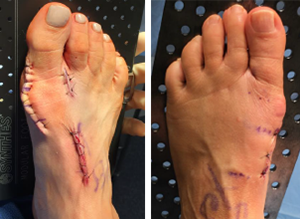WHAT IS MINIMALLY INVASIVE BUNION SURGERY?
If you have a painful bunion, you may be considering surgery. While non-operative treatments like toe spacers and bunion splints may provide pain relief, they do not work to correct a bunion. Only surgery can actually correct a bunion.
There are many different ways to treat a bunion. Minimally invasive bunion surgery has become more common over recent years. The technique allows surgeons to correct a bunion through very small incisions using specialized instruments to cut and fix the bones. Minimally invasive surgery (MIS) is appealing because it can allow for faster recoveries with smaller scars. However, not all patients are good candidates for this surgery.
Diagnosis
A bunion, also called "hallux valgus," is a foot deformity caused by malalignment of the foot bones. It can be something you were born with, but more often, it is the result of your foot bones shifting gradually over years. This shift happens as soft tissues (ligaments, tendons, and joint capsules) stretch out or tighten, leading to worsening of the deformity.
Bunions are diagnosed by physical examination and X-rays. X-rays, taken with you standing on the foot, are important to evaluate the severity of the bunion and determine what type of surgery is most likely to work. Your foot and ankle orthopaedic surgeon may recommend minimally invasive bunion surgery after examining you and looking at X-rays.
Treatments
There are many different types of surgery to correct a bunion. Not all surgeons perform minimally invasive bunion surgery.
The minimally invasive chevron and Akin osteotomies (MICA) is one strategy to correct a bunion. This procedure involves cutting and realigning the bone behind the big toe called the first metatarsal (this is a chevron osteotomy) and the big toe bone (this is an Akin osteotomy). Both bones are held in place with screws. Your foot and ankle orthopaedic surgeon performs the entire procedure through several small incisions measuring less than 1 centimeter. The surgeon uses X-rays to help see what they are doing during the surgery.
An X-ray of a bunion, showing that the large bump on the inside of the foot is caused by malalignment of the bones.
Recovery
Because the incisions are smaller than with traditional bunion surgeries, pain after surgery is typically more mild. After surgery, you will be in a supportive dressing to help hold your toes in the right position. Your surgeon may let you start weightbearing in a special postoperative shoe right after surgery. Typically, this postoperative shoe must be worn whenever you are walking for the first 6 weeks in order to protect the bones as they heal.
Swelling lasts for months after surgery, and it may be several months before you can fit comfortably into your regular shoes. Like with any bunion surgery, full recovery takes up to 6 months to a year.
Risks and Complications
The risks of MICA are similar to the risks of other bunion surgeries. These risks include the risk of the bunion coming back, which can happen right away after surgery, or decades later. Even if the bunion comes back, it usually does not hurt. Other risks include the bones not healing; nerve injury causing numbness, tingling, or pain; painful hardware requiring removal; and infection. The risk of infection might be lower because of the smaller incisions.
Incisions over a bunion treated with open surgery (left) compared to one treated with minimally invasive surgery (right).
(A) An X-ray example of a bunion before surgery
(B) The X-ray showing how the bones have been realigned following minimally invasive bunion surgery (MICA)
(C) The X-ray showing how the bones eventually heal together months after surgery.
What are the advantages of minimally invasive bunion surgery over open surgery?
Because of the smaller scars, recovery from minimally invasive bunion surgery is usually faster and less painful than from open surgery, and there may be less stiffness once you heal. The risk of infection and wound healing problems may also be lower.
Why shouldn’t I get minimally invasive bunion surgery?
Not all patients are good candidates for the MICA procedure. If you have a severe deformity or a bunion combined with a flat foot, then this surgery might not be right for you. Your surgeon may also advise against this surgery if you have very weak bones from osteoporosis. You can discuss whether this procedure might be right for you with a foot and ankle orthopaedic surgeon trained in MICA.
Who does minimally invasive bunion surgery?
Relatively few foot and ankle surgeons perform the procedure because it is a new technique that can be difficult to learn. If you are interested in minimally invasive bunion surgery, you should see a foot and ankle orthopedic surgeon who is trained in this technique.
Original article by Elizabeth Cody, MD
Contributors/Reviewers: David Porter, MD, PhD; Sudheer Reddy, MD
Courtesy https://www.footcaremd.org/


